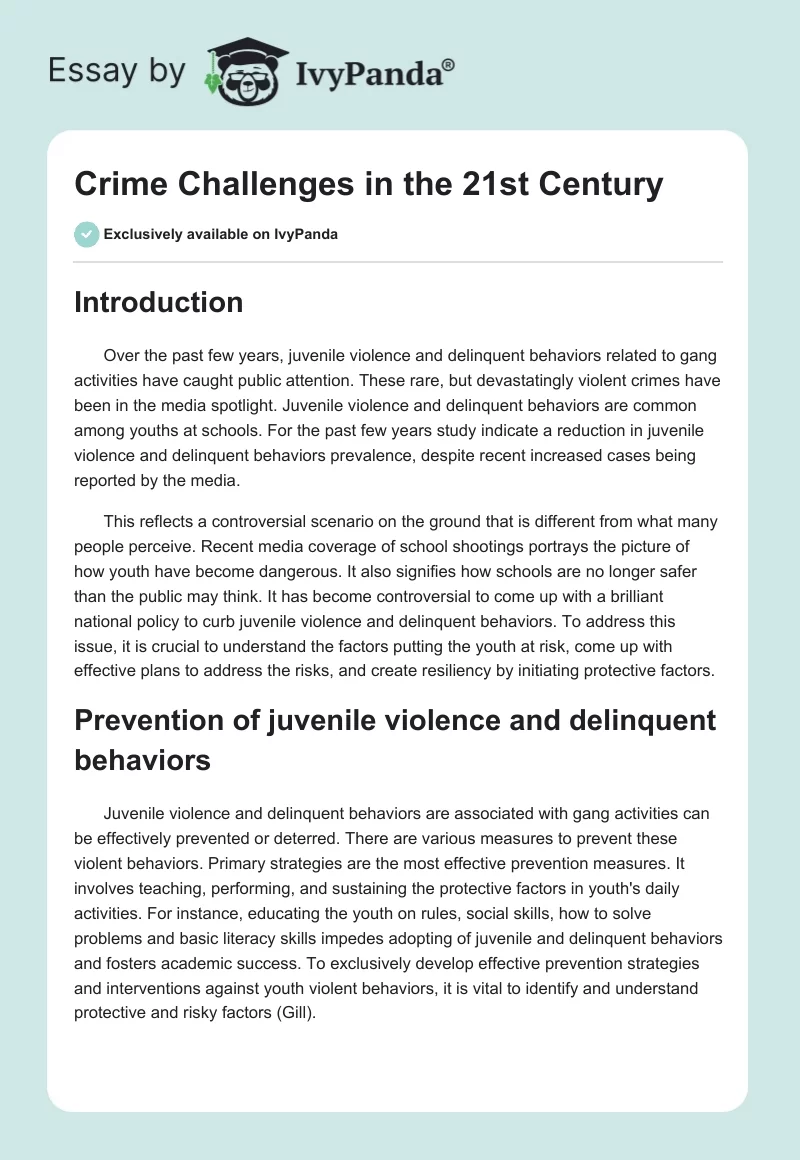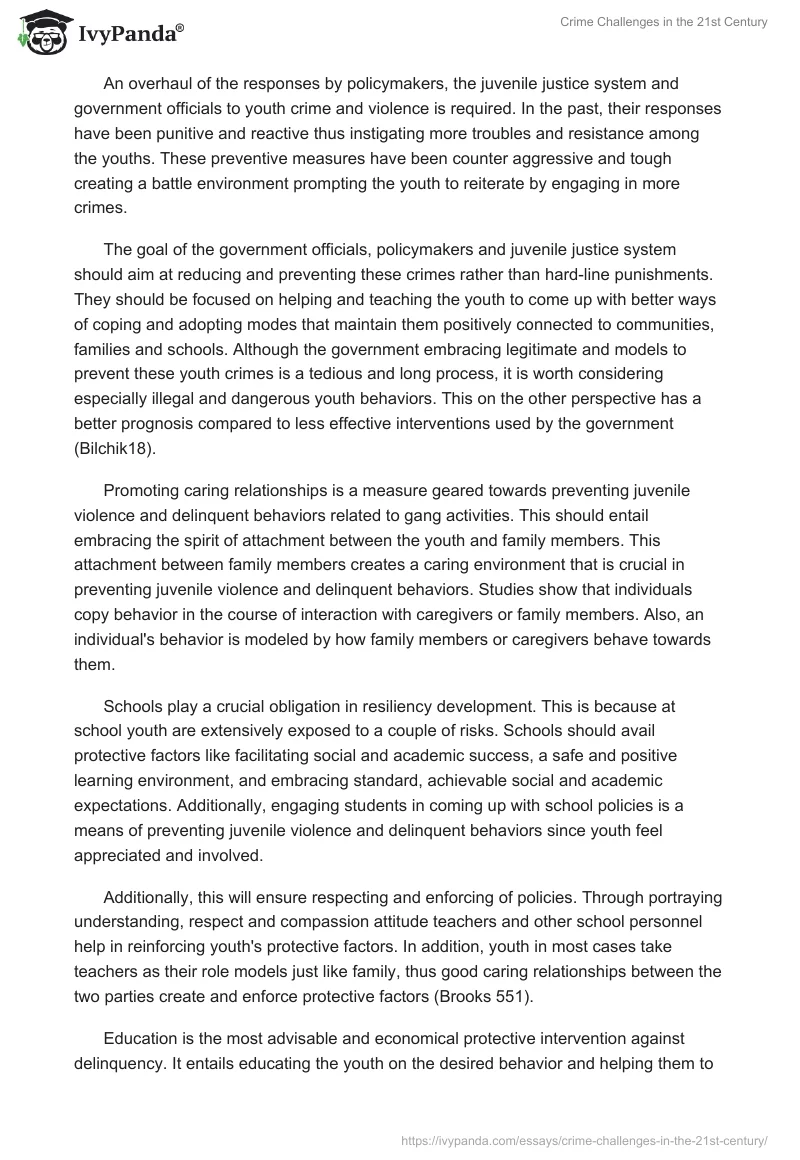Introduction
Over the past few years, juvenile violence and delinquent behaviors related to gang activities have caught public attention. These rare, but devastatingly violent crimes have been in the media spotlight. Juvenile violence and delinquent behaviors are common among youths at schools. For the past few years study indicate a reduction in juvenile violence and delinquent behaviors prevalence, despite recent increased cases being reported by the media.
This reflects a controversial scenario on the ground that is different from what many people perceive. Recent media coverage of school shootings portrays the picture of how youth have become dangerous. It also signifies how schools are no longer safer than the public may think. It has become controversial to come up with a brilliant national policy to curb juvenile violence and delinquent behaviors. To address this issue, it is crucial to understand the factors putting the youth at risk, come up with effective plans to address the risks, and create resiliency by initiating protective factors.
Prevention of juvenile violence and delinquent behaviors
Juvenile violence and delinquent behaviors are associated with gang activities can be effectively prevented or deterred. There are various measures to prevent these violent behaviors. Primary strategies are the most effective prevention measures. It involves teaching, performing, and sustaining the protective factors in youth’s daily activities. For instance, educating the youth on rules, social skills, how to solve problems and basic literacy skills impedes adopting of juvenile and delinquent behaviors and fosters academic success. To exclusively develop effective prevention strategies and interventions against youth violent behaviors, it is vital to identify and understand protective and risky factors (Gill).
An overhaul of the responses by policymakers, the juvenile justice system and government officials to youth crime and violence is required. In the past, their responses have been punitive and reactive thus instigating more troubles and resistance among the youths. These preventive measures have been counter aggressive and tough creating a battle environment prompting the youth to reiterate by engaging in more crimes.
The goal of the government officials, policymakers and juvenile justice system should aim at reducing and preventing these crimes rather than hard-line punishments. They should be focused on helping and teaching the youth to come up with better ways of coping and adopting modes that maintain them positively connected to communities, families and schools. Although the government embracing legitimate and models to prevent these youth crimes is a tedious and long process, it is worth considering especially illegal and dangerous youth behaviors. This on the other perspective has a better prognosis compared to less effective interventions used by the government (Bilchik18).
Promoting caring relationships is a measure geared towards preventing juvenile violence and delinquent behaviors related to gang activities. This should entail embracing the spirit of attachment between the youth and family members. This attachment between family members creates a caring environment that is crucial in preventing juvenile violence and delinquent behaviors. Studies show that individuals copy behavior in the course of interaction with caregivers or family members. Also, an individual’s behavior is modeled by how family members or caregivers behave towards them.
Schools play a crucial obligation in resiliency development. This is because at school youth are extensively exposed to a couple of risks. Schools should avail protective factors like facilitating social and academic success, a safe and positive learning environment, and embracing standard, achievable social and academic expectations. Additionally, engaging students in coming up with school policies is a means of preventing juvenile violence and delinquent behaviors since youth feel appreciated and involved.
Additionally, this will ensure respecting and enforcing of policies. Through portraying understanding, respect and compassion attitude teachers and other school personnel help in reinforcing youth’s protective factors. In addition, youth in most cases take teachers as their role models just like family, thus good caring relationships between the two parties create and enforce protective factors (Brooks 551).
Education is the most advisable and economical protective intervention against delinquency. It entails educating the youth on the desired behavior and helping them to shun away violence and crimes. Having a good and conducive environment is important in exposing youth to positive influences. Also, youth should be presented with a view of neighborhoods that is crucial in mounting resiliency in the face of economic disadvantage. Different concepts reflecting on organizations and social network structures in the communities prevent youth from participating in juvenile violence and delinquent behaviors related to gang activities.
Training and counseling of the youth on a career is important in preventing juvenile violence and delinquent behaviors related to gang activities. This provides vital protective factors since the youths are kept occupied thus unlikely to engage in juvenile violence and delinquent behaviors. Well-programmed after-school engagements, volunteer activities, and recreational activities are some of the ways or measures to support and foster resiliency among the youth. Studies indicate that youths are prone to committing crimes after school hours. It is important to make them occupied during this period with after-school community-based activities to deter them from violence and crimes.
These after-school programs have been proven to have positive results in preventing juvenile violence and delinquent behaviors. Positive youth groups play important role in preventing youth crime and violence, it provides good value and norms which are essential in maintaining resiliency among the youth. Additionally, schools staff such as teachers and families’ members should help youth develop positive social relationships (Herrenkohl and Hill 48).
Government and research agencies should embark on and support projects related to the prevention of juvenile violence and delinquent behaviors. They should come up with criteria that are uniform and geared towards addressing the issue. They should start a campaign to create awareness, pass information and technical information regarding these available programs on juvenile violence and delinquent behaviors aimed at preventing youth crime and violence.
How alternatives to incarceration increase involvement of crime victims
Trends towards alternatives to incarceration will increase the involvement of juvenile violence and delinquent behaviors’ victims. Recreational activities such as sports keep the youth occupied thus preventing them from crimes and violence.
Gang awareness is necessary to the youths. It keeps them involved in other constructive activities and shuns away gang groups. Studies show that most youths engage in gang groups due to a lack of pro-social recreational alternatives. Also, they join gang groups due to dissatisfaction either at home or school. In the alternatives to incarceration programs, parents should have enough time to be with their children and guide them accordingly.
Education is a key pass to attaining better jobs. It is a tool in fighting youth crimes and violence since most gangs are instigated by a lack of jobs and idleness. Governments should divert more funds to educate compared to law enforcement against juvenile violence and delinquent behaviors crimes. Mental health and drug treatment are used as alternative methods of incarceration. Some of the youth involved in violence and crimes are either mentally ill or under drug influence. Courts instead of sentencing juvenile violence and delinquent behaviors’ victims to prison, should put them in designed programs for supervision and treatment. The judges, community health workers, and attorneys should collaborate to ensure that the victims are on the right track and adhering to treatment (Muraskin and Alkbeit).
Community corrections are programs geared to preventing criminal activities. They offer systematic order for the offenders to integrate back into society without having breaching safety or order. They include half-back houses, day reporting centers, and intensive supervision. In conjunction with addressing juvenile violence and delinquent behaviors offenders, they are kept occupied and involved in counseling programs aimed at transforming their behaviors. Intensive parole drug programs are set to monitor juvenile offenders who have a history of drug abuse. Also, they involve youth in activities to avert their behaviors (Guetzloe 23).
Conclusion
In conclusion, failure to embrace recent trends on juvenile violence and delinquent behaviors related to gang activities pose a pervasive problem. Despite the decline in the number of arrests related to these crimes and violence, there is a threat of them escalating in the future due to the increasing trend. It is unfortunate how juvenile violence and delinquent behaviors have become so rampant yet there are no fast interventions to curb this problem.
Every life domain such as peer group, family, and school presents with risk factors for juvenile violence and delinquent behaviors. Risk factors cause juvenile violence and delinquent behaviors. The more the exposure to these risk factors the youth is more likely to develop the behavior. Some risk factors for juvenile violence and delinquent behaviors include cognitive deficits, poor parenting skills, poverty, easy access to weapons such as guns, dropping out of school, and delinquent peers.
Works cited
Bilchik, Smith. “The Office of Juvenile Justice and Delinquency Prevention: A Federal Partner in meeting the Mental Health Needs of Juvenile Offenders.” Focal Point 11.1 (1997): 17-20. Print.
Brooks, Robert. “Children at Risk: Fostering Resiliency and Hope.” American Journal of Orthopsychiatry 64 (1994): 545-553. Print.
Gill, Daniel. Alternatives to the Present uses of the Jails, Institute of Government, University of North Carolina at Chapel Hill, 1967. Print.
Guetzloe, Erickson. “Violence in Children and Adolescents a Threat to Public Health and Safety: A Paradigm of Prevention.” Preventing School Failure 44 (1999): 21-24. Print.
Herrenkohl, Maguin and Kean Hill. “Developmental Risk Factors for Youth Violence.” Journal of Adolescent 5.12 (2000): 45-56. Print.
Muraskin, Roslyn, and Roberts Alkbeit. Visions for Change: Crime and Justice in the 21st Century, New Jersey, Prentice Hall, 2008. Print.


